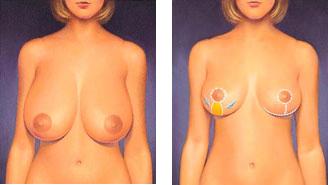Breast Surgery
Breast Reduction
While many women desire large breasts, there are many more women who prefer to have theirs reduced. Large, heavy breasts are extremely incapacitating. They may cause back pain, neck pain, shoulder pain, shoulder grooves and poor posture. They may be embarrassing to young woman and can limit physical activity.
During your consultation, we will thoroughly examine your breasts. We will measure your breasts noting the breast proportions, the position of your nipples and any breast asymmetry. We will show you before and after photographs to help you understand the breast reduction procedure and the typical results.
The techniques for breast reduction vary. We perform the two most common techniques which leave either an anchor-shaped scar or a short vertical scar.

Anchor-shaped scar: This is the most widely used technique by cosmetic surgeons. It leaves a scar around the areola, a vertical scar from the areola to the fold under the breast and a long horizontal scar below the breast, hidden within the breast fold. This operation works well for most women.
The Short-Scar: This technique for breast reduction was initially introduced in the 1960s and has recently regained popularity. It requires experienced surgeons or those who have been specially trained in this technique. Both Dr.Thompson and Dr. Germain perform this type of breast reduction. With this procedure the scar is located around the areola and extends vertically to the breast fold. There may be only a small horizontal extension of the vertical scarbelow the breast which is much more readily concealed than the anchor scar. Ideal women for this operation have moderately large breasts with good skin quality. A small percentage of women will require a minor revision to the lower part of the scar, 6 to 12 months after the procedure to remove any excess skin.
The risks of breast reduction include scars, infection, bleeding (hematoma), poor or delayed healing, reduced nipple sensation, partial or total loss of the nipple, lumps, bottoming-out (drooping of the lower portion of the breast) and an altered capacity to breast feed. We will discuss them with you during your consultation.
For reasons of confidentiality, we chose not to publish photos of our patients. We invite you to consult this Americain website to see photos before and after surgery. http://www.surgery.org/public/photos/breast_reduction



